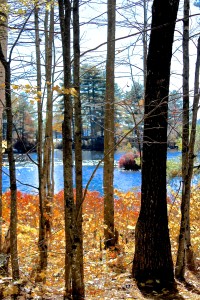Leaf Disposal At Your Maine Lakefront Property
Out and About for the Sebago Lakes Region of Maine Nov. 5-11
November 5, 2015Out and About for the Bangor Lakes Region of Maine Nov. 12-18
November 11, 2015Leaf Disposal At Your Maine Lakefront Property
Leafy Buffer Zone Beside Moose Pond in Bridgton, Maine
Leaf Disposal At Your Maine Lakefront Property
by Leigh Macmillen Hayes
The quality of our Maine lakes is directly dependent on the level of nutrients in the water, specifically phosphorus and nitrogen. Nutrients make their way into the water by way of the watershed, the surrounding elevated area that drains into the lakes, ponds and rivers.
Two main sources of nutrients: soil erosion and every living thing in the watershed.
Think about it. Everything in the watershed that is alive or was alive contributes phosphorous and nitrogen to the lake. Grass clippings, fertilizer, road salt, car oil, leaves, acorns, bird and dog scat, the list goes on.
All of these contain phosphorous and nitrogen that wash into the water by rain and wind. The two nutrients encourage aquatic plants and algae to grow. While the aquatic plants are essential members of the ecosystem, an abundance of nutrients can promote their overgrowth and undesirable amounts of algae.
This fall, when you’re cursing the blanket of leaves at your lakefront property, please consider your impact on the water.
Suggested methods for leaf disposal:
Compost
Composting your leaves turns them into high quality fertilizer for your garden.
Mulch
Another option is to thoroughly chop up your leaves with a mulching lawn mower. Although some of the mulched pieces will find their way into the water, they will also act as a natural fertilizer for your lawn. While this may add some phosphorus to the water, your lawn will require less fertilizer and weed killer next spring.
Methods to avoid:
Blowing leaves directly into the water
Decomposing leaves create bottom “muck” and provide nutrients for future algae blooms. Yes, plenty of leaves end up in the water as a result of the wind; don’t add more.
Burning leaves
Burning leaves creates the largest negative impact on the water. The burning process breaks down the leaf structure and makes the nutrients readily available in the form of ash (no decomposition necessary).
Check out the lakefront properties for sale on Moose Pond in Bridgton, Maine by clicking on the green box above.
For more information about Moose Pond and Bridgton, click on the blog links below.
Moose Pond in the Sebago Lakes Region of Maine, Offers Views, Fishing, Recreation and Clean Water
Bridgton, Maine, Offers Plenty To Do Throughout the Year

